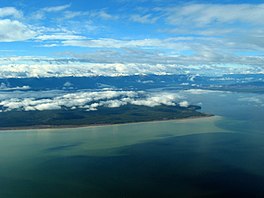Williston Lake
Reservoir in British Columbia From Wikipedia, the free encyclopedia
Reservoir in British Columbia From Wikipedia, the free encyclopedia
Williston Lake is a reservoir created by the W. A. C. Bennett Dam which is located in the Northern Interior of British Columbia, Canada.
| Williston Lake | |
|---|---|
 | |
| Location | British Columbia |
| Coordinates | 56°N 124°W |
| Type | Reservoir |
| Primary inflows | Peace River |
| Primary outflows | Peace River |
| Basin countries | Canada |
| Max. length | 251 km (156 mi) |
| Max. width | 155 km (96 mi) |
| Surface area | 1,761 km2 (680 sq mi)[1] |
| Average depth | 42 m (138 ft) |
| Water volume | 74 cubic kilometres (60,000,000 acre⋅ft) |
| Surface elevation | 671 m (2,201 ft)[2] (level varies by 18 m) |
| References | [1][2] |
The lake fills the basin of the upper Peace River, backing into the Rocky Mountain Trench which is where the Parsnip and Finlay met at Finlay Forks to form the Peace. The lake includes three reaches, the Peace Reach (formerly the Peace Canyon), and the Parsnip and Finlay Reaches, which are the lowermost basins of those rivers, and covers a total area of 1,761 km2 (680 sq mi),[1] being the largest lake in British Columbia and the seventh largest reservoir (by volume) in the world.
The reservoir is fed by the Finlay, Omineca, Ingenika, Ospika, Parsnip, Manson, Nation and Nabesche Rivers and by Clearwater Creek, Carbon Creek, and other smaller creeks.
Several provincial parks are maintained on the shore of the lake, including Muscovite Lakes Provincial Park, Butler Ridge Provincial Park, Heather-Dina Lakes Provincial Park and Ed Bird-Estella Provincial Park.
The following rivers empty into the Williston Reservoir, in clockwise order from the Peace River outlet:
Additionally, the following creeks empty into Williston Reservoir, in clockwise order from the Peace River outlet (this list is not comprehensive):[3]
Williston Lake was created in 1968 by the building of the W. A. C. Bennett Dam on the Peace River, which flooded the aboriginal-territorial home of the Tsay Keh Dene First Nation.[4]
The reservoir was named after the Honourable Ray Gillis Williston, at the time the Minister of Lands, Forests and Water Resources.

Seamless Wikipedia browsing. On steroids.
Every time you click a link to Wikipedia, Wiktionary or Wikiquote in your browser's search results, it will show the modern Wikiwand interface.
Wikiwand extension is a five stars, simple, with minimum permission required to keep your browsing private, safe and transparent.